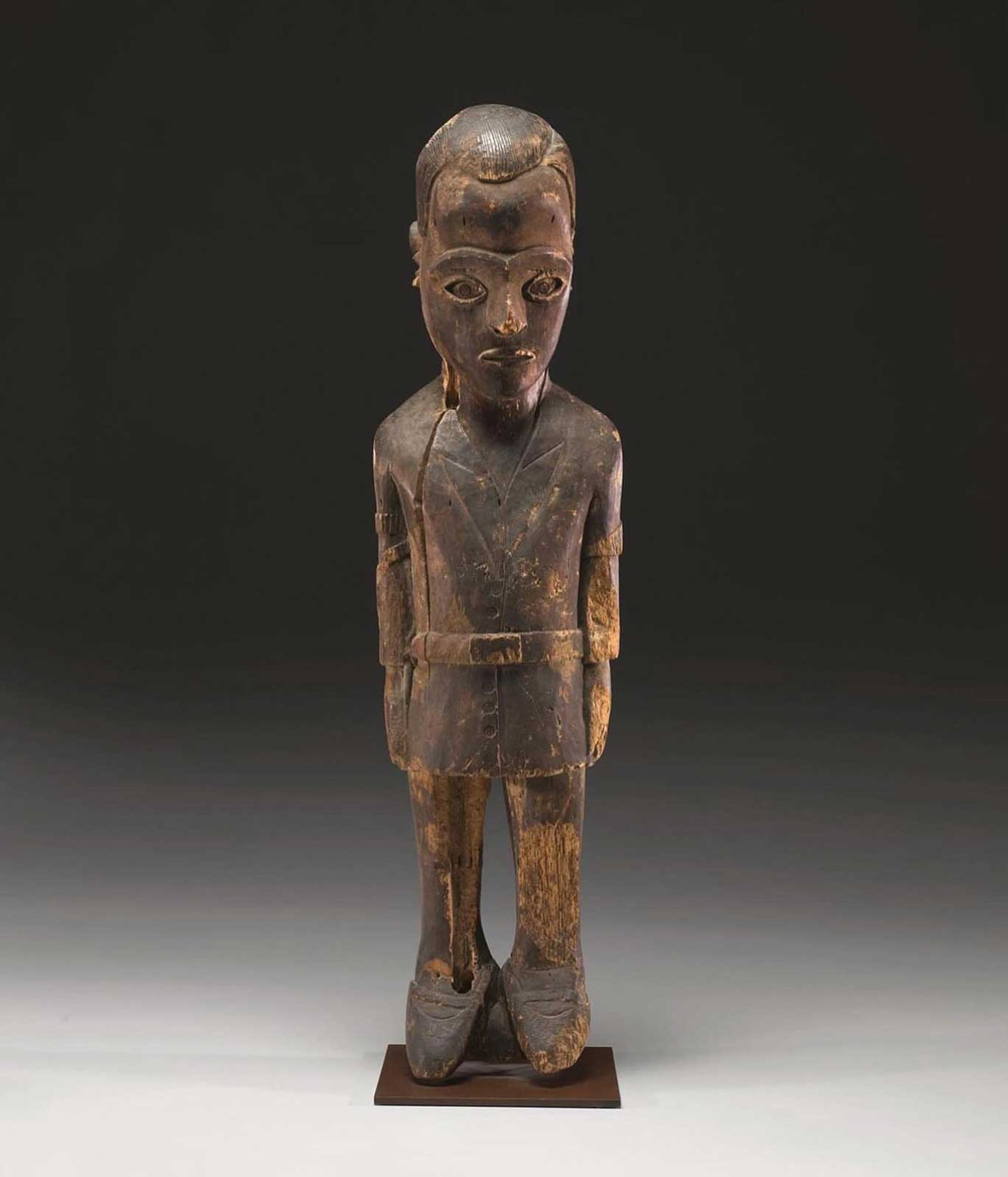A much-anticipated work in the 2024 Venice Biennale will be seen on a video screen, while the object itself will return to its country of origin, albeit as a temporary loan from the US institution that has owned it since 2015.
The sculpture is a wooden effigy from the 1930s of a white colonial administrator, made in the Belgian Congo for a local campaign of revenge that led to the official’s death and launched a rebellion. The Virginia Museum of Fine Arts (VMFA) in the US is allowing the Dutch pavilion at the biennale to stream the sculpture’s image after an initiative by an artists’ co-operative in Congo to sell NFTs (non-fungible tokens) of the sculpture. The object itself will be loaned to the White Cube museum in Lusanga, Democratic Republic of Congo.
The work is Chief’s or Diviner’s Figure Representing the Belgian Colonial Officer, Maximilien Balot (around 1931), a two-foot-high carving in wood of the official who investigated the rape of a woman from the Pende people in the Kwilu region of central Congo. At the time Lusanga was named Leverville for the British palm oil magnate William Lever. (Lever Brothers later became the conglomerate Unilever.)
The rape was committed by a Belgian recruiter of palm nut cutters. The statue was made to focus the resentment of the Pende people towards Maximilien Balot, who was killed in a clash while investigating the rape charges and collecting taxes. Balot’s killers beheaded him, hacked his body apart and divided his remains among the Pende. The clothes and grooming carved on the scowling effigy are those of a colonial official. The Pende rebellion lasted four months and more than 1,300 Africans were killed to avenge Balot’s death, experts say.
The Balot sculpture was sold in Belgium in 1972 for $700 to Herbert F. Weiss, a collector and political science professor from New York specialising in the Congo. Weiss sold it in 2015 to the VMFA for $24,000. A museum spokesperson stressed that the work was acquired legally, although artists in Lusanga called their Balot NFT gambit a “digital restitution”.
In 2017, the Congolese Plantation Workers Art League (CATPC) approached the VMFA to borrow the work for its new White Cube museum on the grounds of the former Lever plantation. The building was designed pro bono by the Office for Metropolitan Architecture (OMA), founded by the Dutch architect Rem Koolhaas. The VMFA rejected the loan request.
The CATPC planned to monetise its members’ contemporary sculptures cast in chocolate to buy land to reforest. With the help of the Dutch artist Renzo Martens, whose films track that regenerative plan over almost 20 years, and the KOW gallery in Berlin, which represents the artists’ group, CATPC issued NFT replicas of the Balot sculpture in 2022. KOW is still selling the NFTs, according to Martens’s publicist.
“Each purchase of one of the 306 NFTs buys and secures two and a half acres of exhausted plantation land,” the CATPC members announced at the time. “Every purchase helps to further unleash the powers of the sculpture, and to re-fulfil its original functions: to protect our land and our people.”
The VMFA called the NFT launch “unethical and unprofessional”, but in February agreed to loan the object and facilitate its presence, via streaming video, in Venice. The Dutch pavilion exhibition, designed by Martens and funded by the Mondriaan Fund—which also funded the transport of the Balot sculpture to Lusanga—will also show sculptures made by members of the CATPC.
Weiss, who is now 93 and based in Washington, DC, provided details to The Art Newspaper about the Balot sculpture and its acquisition. When Balot’s corpse was hacked apart in 1931 after his killing, body parts were distributed among Pende chiefs, in the belief that holding those remains, like the sculpture, would fend off his influence. Only about a third of those remains were ever recovered.
‘No other object that is similar’
In 1972, in the town of Gungu, a local man seeking funds for his children’s school fees offered Weiss two sculptures at $120 each—one was that of Balot, the other a female Pende figure. Weiss bought the female figure and, lacking cash to buy both, interviewed the seller about the Balot figure and its origins. Later that year, Weiss mentioned the Balot figure in Belgium. After that, the Balot sculpture was found in Gungu and brought back to Belgium, where Weiss bought it for $700.
The sullen white man depicted in dark wood has a chilling stiffness. This was not an object made to give pleasure. The sculptor is not known, but a thorough article in African Arts from 2016 by Weiss and two other specialists noted special alterations intended to give power to the sculpture.

Chief’s or Diviner’s Figure Representing the Belgian Colonial Officer, Maximilien Balot, by an unknown artist, around 1931
Virginia Museum of Fine Arts, Aldine S. Hartman Endowment Fund, 2015.3. Photo: Travis Fullerton © Virginia Museum of Fine Arts
“To my knowledge it’s unique,” Weiss tells The Art Newspaper. “I know of no other object that is similar.”
In the fervour since the NFT copies hit the market, Weiss says, Martens and company “have opened a Pandora’s box”. While some are calling for its restitution, “to whom do you restitute it?” Weiss asks. The artists of the CATPC, he says, “are not Pende. Lusanga is not Pende”.
“Unilever has been out of there for years, for decades, so this business of buying back land from the plantation—there is no plantation,” he says “And there’s certainly no European plantation, so that’s a sleight of hand, but anything that brings some wealth, some support, to a rural African area, I am 100% in favour of.”


